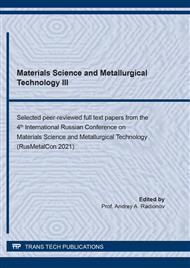p.80
p.86
p.92
p.98
p.104
p.110
p.116
p.122
p.128
Modeling the Structural Strength of Materials on Disk Laboratory Specimens
Abstract:
The article describes the strength characteristics of the material used for highly loaded structural elements by modeling their stress-strain state (SSS) and testing special laboratory samples for strength. The typical biaxial SSS is characterized by a different ratio of the main stresses in the focus of possible destruction, which affects the strength characteristics and requires the use of special equipment for determining strength values in laboratory conditions. To create a biaxial SSS under these conditions is a difficult task, since it requires non-standard laboratory samples and test systems with several power drives or complex lever devices for loading these samples, which limits the use of this testing method in determining the mechanical properties of materials. The article describes a simpler method for testing materials under complex stress-strain using special laboratory disc samples on standard test equipment with one power drive. The disk sample design and methods of deforming and creating test conditions are described.
Info:
Periodical:
Pages:
104-109
Citation:
Online since:
February 2022
Authors:
Price:
Сopyright:
© 2022 Trans Tech Publications Ltd. All Rights Reserved
Share:
Citation:


